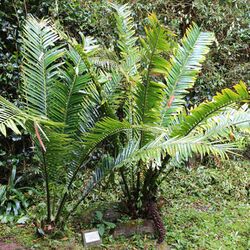Biology:Encephalartos kisambo
| Encephalartos kisambo | |
|---|---|

| |
| Scientific classification | |
| Kingdom: | Plantae |
| Clade: | Tracheophytes |
| Clade: | Gymnospermae |
| Division: | Cycadophyta |
| Class: | Cycadopsida |
| Order: | Cycadales |
| Family: | Zamiaceae |
| Genus: | Encephalartos |
| Species: | E. kisambo
|
| Binomial name | |
| Encephalartos kisambo Faden & Beentje
| |
| Synonyms | |
|
Encephalartos kanga Pócs & Q.Luke | |
Encephalartos kisambo is a species of cycad in the family Zamiaceae.[3] It is known as the Voi cycad.[1]
This species is distributed in the cloud forests of the steep mountain hills at the border of southern Kenya and northern Tanzania. Most grow in misty forest habitat, and some grow on drier rock cliffsides. Some subpopulations are threatened by habitat loss to charcoal production and agriculture, and the species is threatened by overcollection.[1]
Description
Encephalartos kisambo is an arborescent species, with pachycaulous barrel-shaped trunks, with a stem 1.2-2 m high, erect or sometimes decombent, 45-52 cm in diameter. [4]
The pinnate dark green dioecious leaves, arranged like a crown at the apex of the stem, are 240–360 cm long, silvery-green to bluish-green in color, with a 2.5–5 cm long petiole. They are formed by 89-96 pairs of oblong-lanceolate leaflets, opposite, 24–37 cm long and 29–37 mm broad, of leathery consistency, with spiny margin, inserted on the rachis with an angle of 45°.
It is a dioecious species; the male specimens usually have 1 to 5 cones, cylinder-conical, creamy-yellow in color, 49–64 cm long and 10–12.5 cm in diameter; the female ones have from 1 to 5 cones, ovoid, 42–60 cm long, 16–20 cm in diameter, of an orange-yellow color.
The seeds are ovoid, 30–39 mm long, covered with an orange-red flesh.
Distribution
It is native to Kenya and Tanzania. On Mount Kanga, a hill of the Nguru Mountains in the Mvomero district, Morogoro, Tanzania. They are situated on the southern ridge and south eastern slopes of Mt. Kanga at an altitude between 1,000m and 1,300m.[5][6]
References
- ↑ 1.0 1.1 1.2 Eastern Arc Mountains.; Coastal Forests CEPF Plant Assessment Project.; Bösenberg, J.D (2010). "Encephalartos kisambo". IUCN Red List of Threatened Species 2010: e.T41906A10588549. doi:10.2305/IUCN.UK.2010-3.RLTS.T41906A10588549.en. https://www.iucnredlist.org/species/41906/10588549. Retrieved 19 November 2021.
- ↑ "Appendices | CITES". https://cites.org/eng/app/appendices.php.
- ↑ "Encephalartos kisambo Faden & Beentje". The Trustees of the Royal Botanic Gardens, Kew. n.d.. https://powo.science.kew.org/taxon/urn:lsid:ipni.org:names:939351-1.
- ↑ "Encephalartos kisambo". 1970-03-28. http://plantnet.rbgsyd.nsw.gov.au/cgi-bin/cycadpg?taxname=Encephalartos+kisambo.
- ↑ Pócs, Tamás; Luke, Quentin (July 2007). "A New Species of Encephalartos (Zamiaceae) from Tanzania" (in en). Journal of East African Natural History 96 (2): 193–201. doi:10.2982/0012-8317(2007)96[193:ANSOEZ2.0.CO;2]. ISSN 0012-8317.
- ↑ Project, Eastern Arc Mountains & Coastal Forests CEPF Plant Assessment (2009-10-31). "IUCN Red List of Threatened Species: Encephalartos kanga". https://www.iucnredlist.org/en.
External links
- Encephalartos kisambo. Tropicos.
Wikidata ☰ Q3724977 entry
 |




